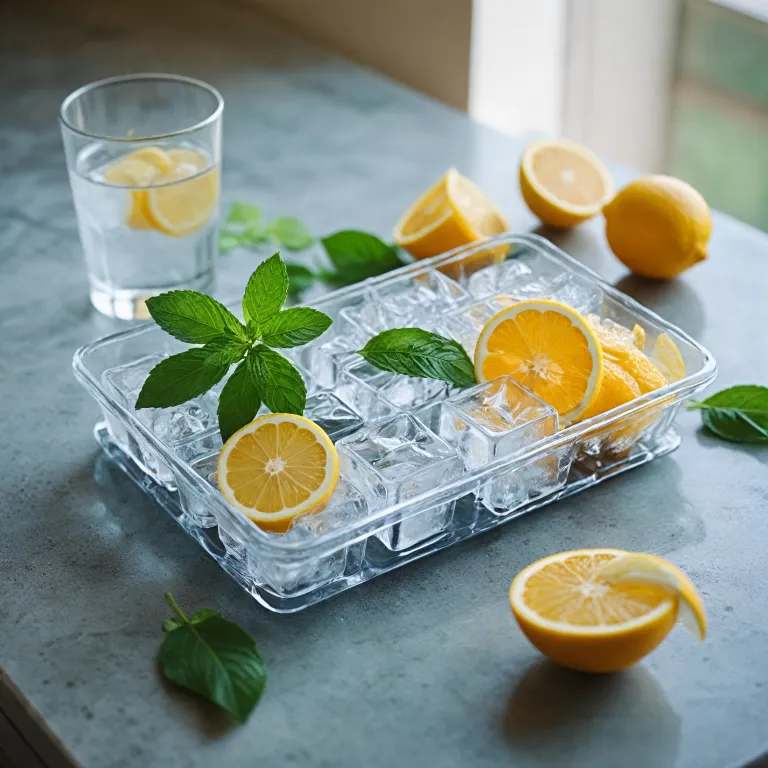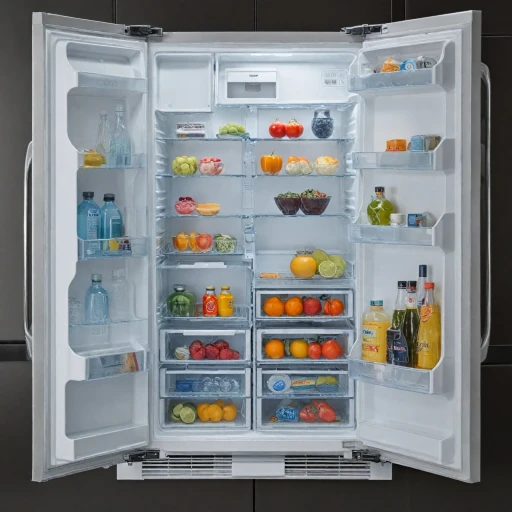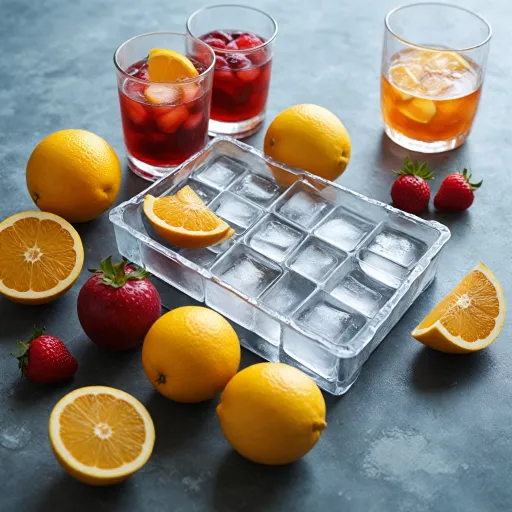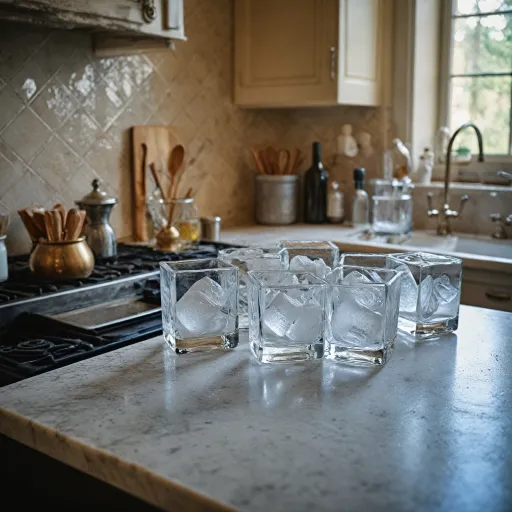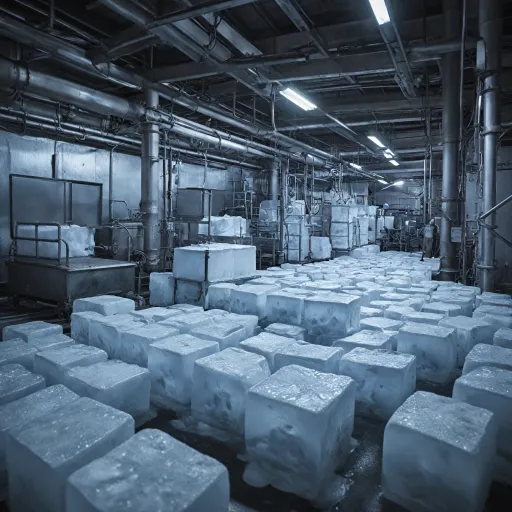
Understanding why ice cubes turn cloudy
Why Do Ice Cubes Often Look Cloudy?
If you have ever made ice at home and noticed that your cubes are cloudy instead of crystal clear, you are not alone. Most home freezers and even many ice makers produce cloudy ice cubes. This happens because of the way water freezes and the impurities or air trapped inside.
- Air bubbles: When water freezes quickly, air gets trapped inside the cube. These air bubbles scatter light, making the ice look cloudy.
- Impurities in water: Tap water often contains minerals and other impurities. As the water freezes, these get pushed to the center of the cube, creating a cloudy core.
- Freezing direction: In most home freezers, ice freezes from the outside in. This traps air and impurities in the middle, instead of pushing them out.
Cloudy ice does not just affect the look of your drink. It can also change the taste of your cocktails or gin tonic, especially if you are using tap water with strong flavors. For the best results in your cocktail or when you want to impress guests, clear ice cubes or even an ice sphere are the top choice. They melt slower and keep your drink colder for longer, without watering it down as quickly.
Understanding these causes is the first step to making clear ice at home. In the next sections, you will learn how to choose the right water, why slow freezing is important, and how to use your ice maker or simple molds to make clear ice cubes. For a deeper dive into the science and techniques behind making clear ice, check out this guide on the art of crafting perfectly clear ice cubes.
Choosing the right water for clear ice
Why the Type of Water Matters for Clear Ice
When you want to make clear ice cubes at home, the water you use is one of the most important factors. Many people notice their ice cubes turn cloudy, especially when using tap water. This is because tap water often contains minerals, impurities, and air bubbles that get trapped as the water freezes. These trapped particles scatter light, making the ice look cloudy instead of crystal clear.
Choosing the Best Water for Clear Ice
If you want to make clear ice cubes for your cocktails or gin tonic, start with the cleanest water possible. Here are some options to consider:
- Distilled water: This is the top choice for making clear ice. Distilled water has had most minerals and impurities removed, so it freezes more clearly.
- Filtered water: Using a good water filter can also help reduce minerals and chlorine, making your ice cubes clearer than with plain tap water.
- Bottled water: Some bottled waters are low in minerals, but always check the label. Not all bottled water is suitable for making clear ice.
For more details on the different types of ice and how water quality affects them, check out this guide on exploring various types of ice for your ice maker.
Reducing Air Bubbles in Your Ice Cubes
Even with the best water, air bubbles can still get trapped in your cubes. To help make clear ice, try boiling your water before freezing it. Let it cool, then pour it into your molds or cube tray. This step helps remove some dissolved air, giving you a better chance at clear cubes.
Remember, the water is just one part of the process. The way you freeze your cubes and the tools you use also play a big role in making clear ice. In the next steps, you’ll learn how slow freezing and the right equipment can make a big difference in your results.
The importance of slow freezing
Why Slowing Down the Freezing Process Matters
If you want to make clear ice cubes at home, slowing down the freezing process is a crucial step. When water freezes too quickly, air bubbles and impurities get trapped inside the cube, leading to cloudy ice. By controlling the freezing speed, you give air and minerals time to escape, resulting in crystal clear cubes that look great in any cocktail or gin tonic.
- Directional freezing: This method involves freezing water from one direction—usually from the top down. It mimics how nature forms clear ice in lakes. You can achieve this at home by using a small cooler inside your freezer. Place the cooler with water (preferably distilled or filtered) in your freezer with the lid off. The ice will freeze from the top, pushing air and impurities to the bottom, which you can trim off later with an ice pick or serrated knife.
- Temperature control: Set your freezer to a slightly warmer setting, just below freezing. This slows the process and helps create clear ice blocks or spheres. Rapid freezing traps air bubbles, so patience is key.
- Cube size and molds: Larger molds or trays take longer to freeze, which helps with clarity. Silicone molds or insulated cube trays are popular for making clear ice spheres or blocks. Smaller cubes freeze faster and are more likely to turn cloudy.
Some modern ice makers use directional freezing technology to make clear ice automatically. If you’re using an ice maker, check if it has a feature that controls the freezing direction or speed. For more on how ice makers manage the freezing process, you can read about the ice level control board in Whirlpool ice makers and how it impacts ice quality.
Remember, the water you use and the way you freeze it both play a big role in the final clarity of your cubes. Take your time with this step, and you’ll be rewarded with ice that’s perfect for your next drink or cocktail party.
Using your ice maker for clear ice cubes
Getting the Most from Your Ice Maker
Many ice makers promise clear ice cubes, but not all deliver the same results. If you want to make clear ice at home, your ice maker can be a great tool—if you use it right. Here are some practical steps to help you get the best, crystal clear cubes for your cocktails and drinks:
- Start with the right water: Using filtered or distilled water helps reduce minerals and impurities that cause cloudy ice. Tap water often contains air bubbles and minerals that make cubes look cloudy.
- Pre-chill your water: Cold water freezes more evenly, which can help minimize air bubbles and make clear ice cubes. Let your water sit in the fridge for a few hours before pouring it into your ice maker or molds.
- Use the right molds or trays: Some ice makers come with special molds or trays designed for directional freezing. These help push air and impurities to the bottom, leaving the top of the cube clear. If your machine supports it, use these features for the best results.
- Don’t rush the process: The slower the freezing, the clearer your ice will be. Some ice makers have a slow-freeze or "clear ice" setting. If yours does, use it. If not, try placing your ice maker in a cooler part of your freezer to slow down the process.
- Store ice properly: Once your cubes are ready, store ice in a sealed bag or container to prevent them from absorbing freezer odors. This also helps keep your cubes clear and fresh for your next gin tonic or cocktail.
Remember, even the best ice maker can produce cloudy ice if you skip steps like using clean water or slow freezing. If you want to make clear ice spheres or blocks for special drinks, consider using molds that fit your ice maker, and finish shaping with an ice pick or serrated knife for that professional touch. Making clear ice at home takes a bit of patience, but the results are worth it—especially when you see that crystal clear cube in your next cocktail.
Simple tools and DIY methods for clear ice
DIY Tools and Methods for Crystal Clear Ice
Making clear ice cubes at home is easier than you might think, even without a professional ice maker. With a few simple tools and a bit of patience, you can create ice that looks stunning in any cocktail or gin tonic. Here are some effective ways to make clear ice using common items found in most kitchens.
- Directional Freezing with a Cooler: Use a small insulated cooler that fits in your freezer. Fill it with filtered or distilled water, leaving the lid off. The insulation slows the freezing process and encourages the ice to freeze from the top down, pushing air bubbles and impurities to the bottom. Once frozen, remove the ice block and cut off the cloudy part at the base. This method produces large, clear ice blocks perfect for cutting into cubes or spheres.
- Silicone Molds: High-quality silicone molds can help shape your ice into cubes or spheres. For best results, use distilled water and freeze slowly. Some molds are designed for directional freezing, further reducing air bubbles and cloudiness.
- Cube Trays with Lids: Trays with lids help prevent freezer odors from affecting your ice. For clearer cubes, use boiled and cooled water, and fill the trays slowly to minimize trapped air.
- Cutting and Shaping Tools: Once you have a clear ice block, use a serrated knife or ice pick to cut ice into the desired shape. This step is especially useful for making ice spheres or large cubes for cocktails.
Remember, the key to making clear ice is controlling the freezing process and using the right water. Take your time, and don't rush the freezing step. Store ice in a sealed container to keep it clear and fresh for your next drink. With a little practice, your homemade ice cubes will rival those served at the top cocktail bars.
Common mistakes to avoid when making clear ice
Frequent Pitfalls When Making Clear Ice at Home
- Using tap water without filtering: Tap water often contains minerals and impurities that can cause cloudy ice cubes. For the best results, use distilled or filtered water to make clear cubes for your cocktails or gin tonic.
- Freezing too quickly: If you place your cube tray or molds directly in the coldest part of the freezer, the water will freeze rapidly, trapping air bubbles and creating cloudy ice. Slow freezing, such as using a cooler or directional freezing method, helps air escape and makes the ice clear.
- Ignoring air bubbles: Air is a top reason for cloudy ice. Make sure to fill your molds or trays slowly to avoid introducing extra air. Letting the water sit for a bit before freezing can also help air bubbles rise and escape.
- Overfilling molds or trays: Filling your molds to the very top can cause water to spill over and freeze unevenly. This can lead to cloudy spots or misshapen cubes, especially if you want a perfect ice sphere or block for a cocktail.
- Not cleaning your ice maker or molds: Residue from previous batches or minerals from water can build up over time. Clean your ice maker, molds, and trays regularly to keep your cubes crystal clear and tasting fresh.
- Storing ice incorrectly: If you store ice cubes in an open container or leave them in the freezer too long, they can absorb odors and develop a frosty surface. Store ice in a sealed bag or container to keep it clear and fresh for your next drink.
- Skipping the cut and polish step: For those who want the best presentation, use an ice pick or serrated knife to cut ice blocks or spheres. This step helps remove cloudy edges and gives you a professional look for top cocktails.
By avoiding these common mistakes, you will make clear ice cubes that elevate every drink, from a simple water glass to an impressive gin tonic. Take your time with each step, use the right tools, and enjoy the difference clear ice makes in your cocktails.
-logo-retina.jpg)
